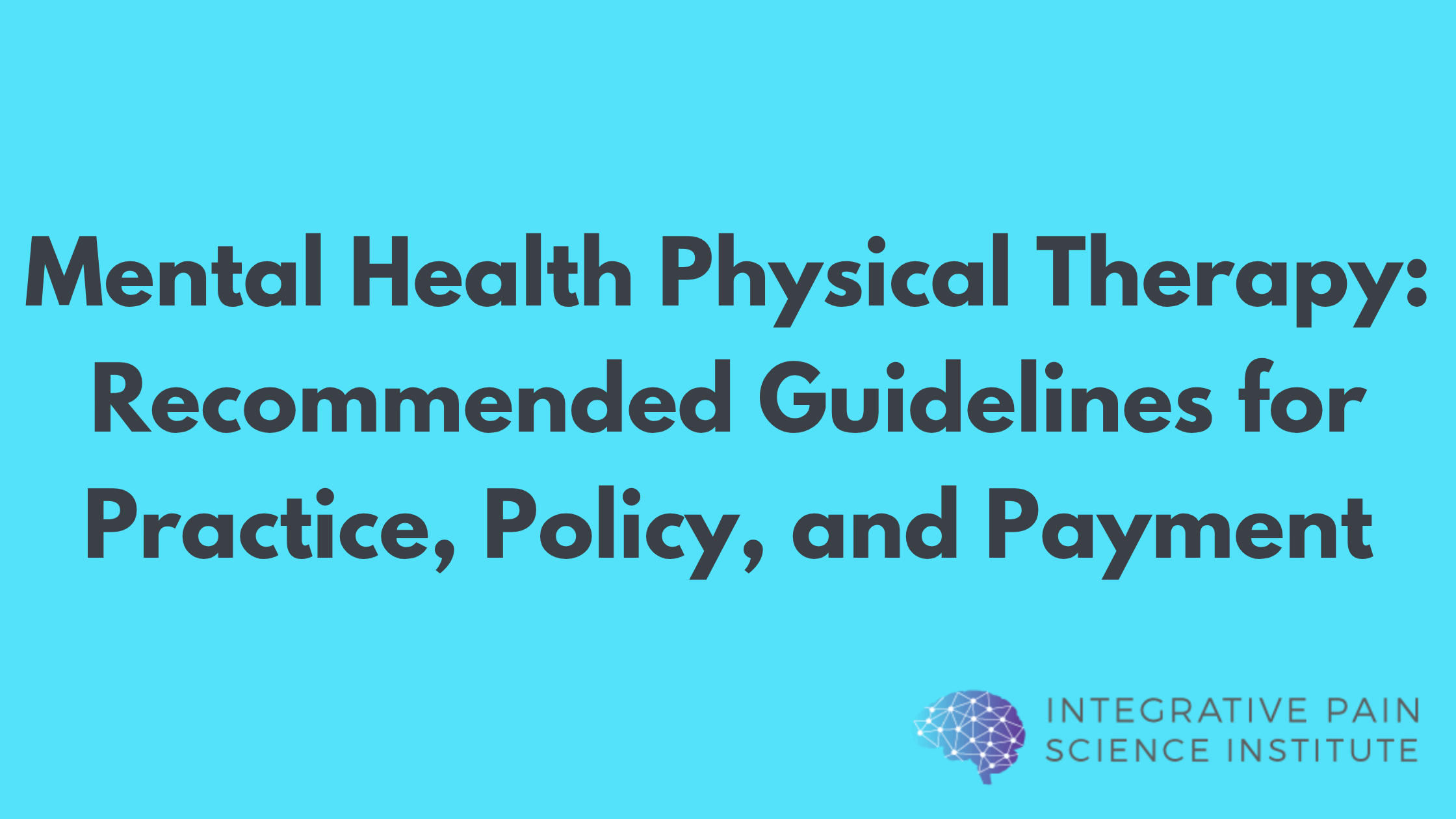How many times have you seen the words “not medically necessary” on a denial letter for a patients bill?
How many times have you provided quality, evidence-based, one-one-one patient pain care only to receive a letter from the insurance company that the claim was DENIED!

When a claim is denied a practitioner’s first instinct is to reflect on the code they used to bill a procedure… AKA the CPT code.
Should I have used 97110? Maybe 97530? 97112? 97129? 97130?
Below I’ll share some of the winning lottery numbers you can use to code and bill services such as Psychologically Informed Physical Therapy (PIPT), including Cognitive Behavioral techniques such as Acceptance and Commitment Therapy, Mindfulness and Pain Education.
But let me share a secret with your first…
In my review of tens of thousands of physical therapist, occupational therapist, and physician medical records, the CPT code is NOT the problem…
It was that care was not taken by the clinician to defensibly document the service!
In other words, you must objectively test and document an impairment during the initial evaluation, specify all interventions you will use in the initial plan of care, relate the interventions to the patient’s physical impairment, and make sure to carry all of this through to each subsequent treatment session.

When you follow the above, your chances of getting paid for your hard work dramatically increases.
Here are some codes, and other comments, related to the use of the newer biopsychosocial interventions used to treat pain including Psychologically Informed Physical Therapy (PIPT), Cognitive Behavioral Therapy, Acceptance and Commitment Therapy, Mindfulness and Pain Science Education:
Cognitive-Behavioral Interventions
There is a pervasive myth that cognitive-behavioral skills and interventions are new to physical therapy and that the only professionals who use them are psychologists. We (PTs and other licensed health providers) have for a very long time included behavioral interventions in our practice and care of pain. The very definition of that is a home exercise program, or changing someone’s gait pattern. We have also used psychological principles too – motivation techniques, visualizing performance, relaxation techniques, etc.
With the psychologically informed paradigm we are intentionally targeting patient beliefs, emotions, and behaviors for pain management and pain self-management, and doing it in a structured/intentional way (before it likely happened, but wasn’t as intentional).
This is more of a Pain Evolution in practice rather than a Pain Revolution.
It is completely consistent with the therapist playing the role of a coach and/or counselor. We are not diagnosing or treating psychopathology. We are using skills to help people cope with pain, fear of pain, fear of movement, and a return to physical function.

Psychologically informed pain care is well within the scope of practice for physical therapists (1). Furthermore systematic review and meta-analyses support the effectiveness of psychological interventions delivered by physiotherapists on pain, disability and psychological outcomes for musculoskeletal pain conditions (2)
Use the following CPT codes to bill PIPT: 97530, 97112, 97129, 97130, 97151, 97152, 97153
The above codes may also apply to your favorite flavor of Pain Education, PNE, EP, CFT, etc. Below are the descriptions for each CPT code along with possible examples in clinical practice:
- Therapeutic Activities (97530) : “The clinician uses dynamic therapeutic activities designed to achieve improved functional performance” (3)
- Example: Education focusing on pacing yourself, graded activity and exposure
- Neuromuscular Re-Education (97112): “The clinician and/or patient perform activities to one or more body areas that facilitate reeducation of movement, balance, coordination, kinesthetic sense, posture, and proprioception”
- Example: Education about pain, neuroplasticity, our nervous system, etc
- Cognitive Intervention (97129): “Therapeutic interventions that focus on cognitive function (e.g., attention, memory, reasoning, executive function, problem solving, and/or pragmatic functioning) and compensatory strategies to manage the performance of an activity (e.g., managing time or schedules, initiating, organizing and sequencing tasks)” – Initial 15 minutes (4)
- Cognitive Intervention (97130): each additional 15 minutes
- Behavioral Identification Assessment (97151): “Behavior identification assessment, administered by a physician or other qualified health care professional” (5)
- Example: administering the Fear Avoidance Beliefs Questionnaire
- Behavior Identification – Supporting Assessment (97152): “Behavior identification supporting assessment, administered by one technician under the direction of a physician or other qualified healthcare professional” (5)
- Adaptive Behavior Treatment (97153): “Adaptive behavior treatment by protocol” (5)
As you can see there are multiple possible codes you can use to bill for psychologically informed physical therapy…how do you choose which one to use? More importantly, how do you choose one that is accepted by insurance?
Dr. Tatta’s simple and effective pain assessment tools. Quickly and easily assess pain so you can develop actionable solutions in less time.
Billing and coding is specific to each insurance provider and differs from state to state, which can make this even more confusing. The best rule of thumb is to ensure that whatever code used is accepted by that patient’s particular insurance plan. This may take some work and include checking online, communication with your billing department, or calling the insurance provider. If only one code could cover pain education, it would likely by neuromuscular reeducation (97112) because we know that we are able to change the nervous system by educating patients about pain.
Additionally, is it essential to use defensive documentation when describing the education provided. Documenting “pt educated about pain” simply will not cut it. Documentation should include at least the following elements:
- What topics were introduced or expanded upon
- Example: sensition, neuroplasticity, spreading pain, endogenous mechanisms, etc.
- Purpose of including particular topic(s)
- Use of metaphors, visual aids, etc
- Homework assigned if applicable
By utilizing codes accepted by the particular patient’s insurance provider and backing it up with thorough, detailed, and defensible documentation as to what was done and why the patient will benefit you place yourself in a much better position to be reimbursed by the insurance company. Individual insurance companies may have their own unique rules and recommendations and it is important to check your insurance contracts.
Many practitioners still do not bill for the time they spend skillfully educating and counseling a patient on pain self-management techniques. This is a painful trap many practitioners fall into right out of school. As licensed health professionals we should skillfully document the treatment provided and expect to receive reimbursement.
Psychologically Informed Physical Therapy (PIPT) is not new, it is here to stay and in the future all health care professionals will spend more time motivating and working on behaviour change, coaching and employing cognitive-behavioural skills that guide people with pain toward safe and effective pain self-management and recovery.

Shelby McClure is a third year Doctorate of Physical Therapy student at Augusta University in Augusta, Georgia and will be graduating in May of 2020. She completed her undergraduate education at Auburn University in Alabama where she earned a B.S. in Fitness, Conditioning, and Performance in addition to a B.S. in Nutrition and Wellness.
Shelby began dancing at a young age which helped to shape her initial interest in health. During college, she worked as a dance instructor as well as a group fitness instructor, which eventually led her to pursue a career in physical therapy.
Throughout her time at Augusta University and subsequent clinical rotations, Shelby realized her passion for pain science and psychologically informed physical therapy. Shelby is currently completing a 4-week elective with the Integrative Pain Science Institute prior to her graduation.
Shelby is from the Atlanta, Georgia area where she currently resides with her husband of 2 years.
To learn more about Shelby, visit her LinkedIn.
REFERENCES
- Francis J Keefe, Chris J Main, Steven Z George, Advancing Psychologically Informed Practice for Patients With Persistent Musculoskeletal Pain: Promise, Pitfalls, and Solutions, Physical Therapy, Volume 98, Issue 5, May 2018, Pages 398–407, https://doi.org/10.1093/ptj/pzy024
- https://www.ncbi.nlm.nih.gov/pubmed/29554030
- Bell A. Compliance Matters: Physician Fee Schedule Coding Updates. APTA. http://www.apta.org/PTinMotion/2020/2/ComplianceMatters/. Published February 2020. Accessed April 9, 2020.
- CPT Code Definitions. https://medicalprofessionals.aurorahealthcare.org/students/rehab/art/cpt-codes.pdf. Published 2008. Accessed April 9, 2020.
- Supplemental Guidance on Interpreting and Applying the 2019 CPT Codes for Adaptive Behavior Services. https://www.abainternational.org/ABAIUploads/Practice/New_CPT_Codes_Supplemental_Guidance_1_9_19.pdf. Published January 2019. Accessed April 11, 2020.
- Louw, A., Schmidt, S., Puentedura, E. and Zimney, K., 2018. Pain Neuroscience Education. 2nd ed. Minneapolis, MN: OPTP, pp.334.



